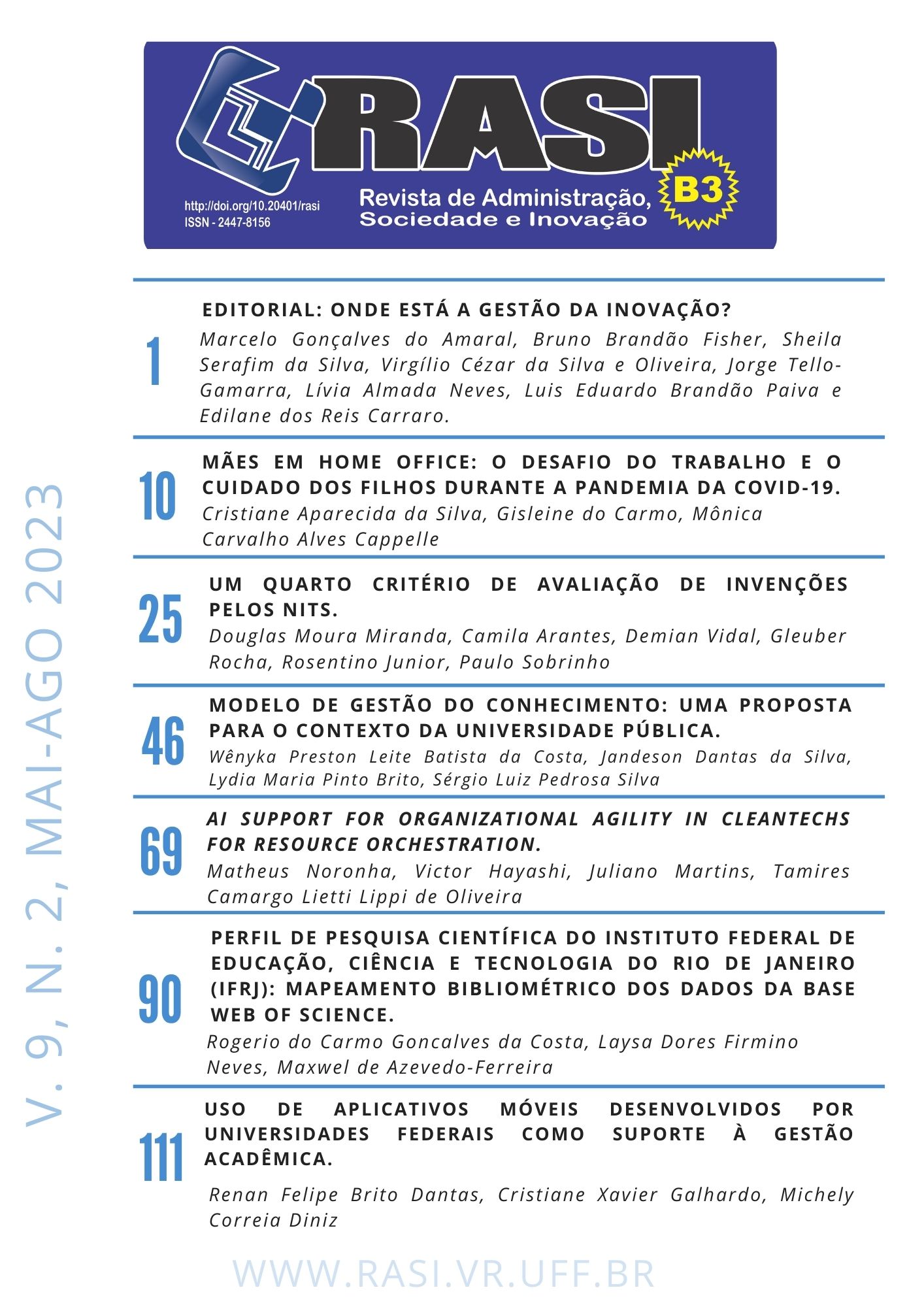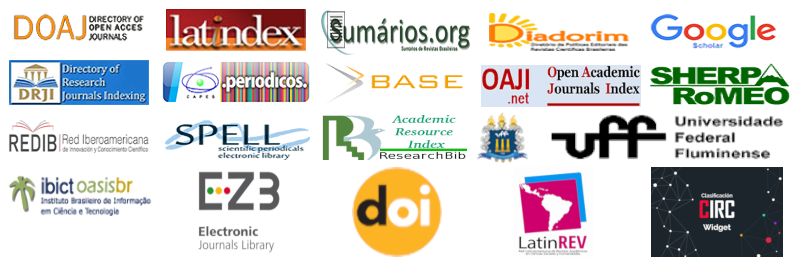A fourth criterion for evaluating inventions by TTOs
DOI:
https://doi.org/10.20401/rasi.9.2.700Keywords:
technology assessment, TTO, Technology Transfer Offices, patentsAbstract
In a context in which the technology transfer rate of Brazilian universities has not followed the growth in the number of patent applications and letters patent, the present work suggests the inclusion of an evaluation of the commercial potential of an invention by the Technology Transfer Offices (TTO) in addition to the evaluation of the three patentability criteria, that is, before the application is filed with the National Institute of Industrial Property. Considering the lack of assessment methods compatible with the reality of an academic TTO, this work develops a new technology assessment method designed to be integrated into the operational routines of this institution. The development starts from a large set of 201 evaluation criteria obtained in the literature, filter it to 151 criteria after an initial analysis, performs prioritization with the help of a committee, and using multi-criteria decision methods identifies weights for the criteria. The work develops four sets of criteria (versions from 26 to 59), so that one of them is used according to the stage of the research, development and innovation project. To illustrate the utilization of the method, it is applied to one real invention. The case study demonstrated that the method can be applied in approximately 73 minutes and is therefore easy to use.
Downloads
References
Abbas, A., Zhang, L., & Khan, S. U. (2014). A literature review on the state-of-the-art in patent analysis. World Patent Information, 37, 3-13.
Allison, J. R., Lemley, M. A., & Walker, J. (2010). Patent quality and settlement among repeat patent litigants. Geo. LJ, 99, 677.
Amarante Segundo, Gesil Sampaio. (2018). O papel dos Núcleos de Inovação Tecnológicas na Gestão da Política de Inovação e sua relação com as empresas. In.: SOARES, Fabiana de Menezes & PRETE.
Bandarian, Reza (2007) Evaluation of Commercial Potential of a New Technology at the Early Stage of Development with Fuzzy Logic.
Journal of Technology Management & Innovation, vol. 2, núm. 4, 2007, pp. 73-85
Bekkers, R., & Freitas, I. M. B. (2008). Analysing knowledge transfer channels between universities and industry: To what degree do sectors also matter? Research policy, 37(10), 1837-1853.
Belina, B., G, T., ?opaci?ska, L., & Walasik, M. (2013). Setting of criteria in the commercial potential assessment method of innovative technological solutions. Problemy Eksploatacji.
CGU (2020). Relatório de avaliação. Ministério da Ciência, Tecnologia, Inovações e Comunicações. Secretaria de Empreendedorismo e Inovação Município/UF: Brasília/Distrito Federal.
Dalmarco, G. et al. Universities’ intellectual property: path for innovation or patent competition? Journal of Technology and Management Innovation, v. 6, p. 159-170, 2011.
de Oliveira, J. L. C., de Oliveira, F. H. P., Carvalho, J. F. S., & Silva, S. W. (2020). A relação entre o Sistema Nacional de Inovação (SNI) e valoração de tecnologias. Engineering Sciences, 8(2), 91-103.
de Carvalho, B. G., & Tonelli, D. F. (2020). Limites e Possibilidades do Marco Legal da CT&I de 2016 para as Instituições Científicas e Tecnológicas do Brasil. Revista de Administração, Sociedade e Inovação, 6(2), 6-24.
Dias, A. A., & Porto, G. S. (2014). Como a USP transfere tecnologia? Organizações & Sociedade, 21(70), 489-507.
EPO (2018). IPscore -Patent Portfolio Management with IPscore 2.2. https://www.epo.org/searching-for-patents/business/ipscore.html
Ferreira, A. R., & Souza, A. L. (2019). Análise dos Procedimentos e Critérios Necessários à Valoração de Propriedade Intelectual para a Transferência de Tecnologia no Âmbito dos Núcleos de Inovação Tecnológica (NITs). Cadernos de Prospecção, 12(5 Especial), 1013.
Ferreira, A. R. F., de Souza, A. L. R., Silvão, C. F., Marques, E. F., de Faria, J. A., & Ribeiro, N. M. (2020). Valoração de Propriedade Intelectual para a Negociação e Transferência da Tecnologia: O caso NIT/IFBA. Navus-Revista de Gestão e Tecnologia, 10, 01-23.
Ferreira, J. P. C., & Carvalho, T. V. (2021). Estudo sobre Valoração de Tecnologia Aplicado ao Núcleo de Inovação Tecnológica do SENAI-CE. Cadernos de Prospecção, 14(1), 23.
Gimenez, P., & Johnson, J. (2020). The Double Diamond as Metaphor for the Research Process
Global Innovation Index. (2021). Consultado em 31 March 2021, from https://countryeconomy.com/government/global-innovation-index/brazil
Gustafsson, D. (2019). Analysing the Double diamond design process through research & implementation.
Hsieh, C. H. (2013). Patent value assessment and commercialization strategy. Technological forecasting and social change, 80(2), 307-319.
Jamwal, A., Agrawal, R., Sharma, M., & Kumar, V. (2021). Review on multi-criteria decision analysis in sustainable manufacturing decision making. International Journal of Sustainable Engineering, 1-24.
Jorio, Ado & Juliana Crepalde. (2018). Estudo preliminar das etapas de desenvolvimento dos Núcleos de Inovação Tecnológica (NIT): análise do equilíbrio entre a atividade de proteção de propriedade intelectual e transferência de tecnologia. Parcerias Estratégicas, v. 23, n. 47, pp. 49-62, jul-dez. Brasília.
Kapoor, R., Karvonen, M., & Kässi, T. (2013). Patent value indicators as proxy for commercial value of inventions. International Journal of Intellectual Property Management, 6(3), 217-232.
Kim, P. H., Kotha, R., Fourné, S. P., & Coussement, K. (2019). Taking leaps of faith: Evaluation criteria and resource commitments for early-stage inventions. Research Policy, 48(6), 1429-1444.
Lerner, J., & Farrar, A. L. (2006). Valuing Patents for licensing: A Practical survey of literature.
Lundqvist, M. (2014). A packaging approach for evaluating ideas.
Matsuura, J. H. (2004). An Overview of Intellectual Property and Intangible Asset Valuation Models. Research Management Review, 14(1), 33-42.
Mierzwa, T. (2016). Which innovation strategy: technology?push or market?pull?. Coursera Inc. Saatavilla: https://www. coursera. org/learn/innovative-entrepreneur/lecture/vwOIB/whichinnovation-strategy-technology-push-or-market-pull.
Odu, G. O. (2019). Weighting methods for multi-criteria decision-making technique. Journal of Applied Sciences and Environmental Management, 23(8), 1449-1457.
Oslo Manual (2018), OECD/Eurostat 2018: Guidelines for Collecting, Reporting and Using Data on Innovation, 4th Edition, The Measurement of Scientific, Technological and Innovation Activities, OECD. Publishing, Paris/Eurostat, Luxembourg.
Parr, R. (2007). Royalty rates for licensing intellectual property. Hoboken: John Wiley & Sons. 219 p.
Quintella, C. M., TEODORO, A. D. O., Frey, I. A., Ghesti, G. F., Braga, M., & dos Anjos, S. S. N. (2019). Valoração de ativos de propriedade intelectual. Embrapa Agroenergia-Capítulo em livro técnico (INFOTECA-E).
Rahal, A. D., & Rabelo, L. C. (2006). Assessment framework for the evaluation and prioritization of university inventions for licensing and commercialization. Engineering Management Journal, 18(4), 28-36.
Reitzig, M. (2003). What determines patent value? Insights from the semiconductor industry. Research policy, 32(1), 13-26.
Rostek, K. (2014). Modeling commercial potential of innovative projects. International Review of Management and Business Research, 3(1), 78.
Santos, D. T. E.; Santiago, L. P. (2008). Métodos de Valoração de Tecnologias. Instituto Inovação.
Schwab, K. (2019). The global competitiveness report 2019. In World Economic Forum
Souza, R. D. O. (2009). Valoração de ativos intangíveis: seu papel na transferência de tecnologias e na promoção da inovação tecnológica. Rio de Janeiro: Universidade Federal do Rio de Janeiro.
Squicciarini, M., Dernis, H., & Criscuolo, C. (2013). Measuring patent quality: Indicators of technological and economic value.
Swamidass, P. M.; Vulasa, V. (2009). Why university inventions rarely produce income? Bottlenecks in university technology transfer. The Journal of Technology Transfer, v. 34, p. 343-363.
Thoma, G. (2014). Composite value index of patent indicators: Factor analysis combining bibliographic and survey datasets. World patent information, 38, 19-26.
Trappey, A. J., Trappey, C. V., Wu, C. Y., & Lin, C. W. (2012). A patent quality analysis for innovative technology and product development. Advanced Engineering Informatics, 26(1), 26-34.
Tukoff-Guimarães, Y. (2013). Valoração de patentes em universidades públicas do estado de São Paulo. Dissertação. Universidade Nove de Julho.
Tukoff-Guimarães, Y. B., Kniess, C. T., Penha, R., & Ruiz, M. S. (2021). Patents valuation in core innovation: case study of a Brazilian public university. Innovation & Management Review.
Vilas Boas Ribeiro, A. T., & Pires Vasconcellos, E. (2019). Diligência da Inovação: Estudo de Caso sobre uma Metodologia de Avaliação Tecnológica no Contexto de NITs Brasileiros. Future Studies Research Journal: Trends & Strategies, 11(2).
Web of Science Group (2019). Research in Brazil: Funding excellence: Analysis prepared on behalf of CAPES by the Web of Science Group.
Zemlickien?, V., Bublien?, R., & Jakubavi?ius, A. (2018). A model for assessing the commercial potential of high technologies. Oeconomia copernicana, 9, 29-54.
Downloads
Published
Versions
- 2023-05-05 (3)
- 2023-05-05 (2)
- 2023-05-01 (1)
Issue
Section
License
Copyright (c) 2023 Review of Administration, Society and Innovation

This work is licensed under a Creative Commons Attribution 4.0 International License.
RASI, in accordance with Law No. 9,610 of February 19, 1998, which amends, updates and consolidates Brazilian copyright law and makes other provisions, adopts the following conditions of the Copyright Assignment:
1. RASI maintains, with the transfer of copyrights, the possession of rights over the content published;
2. The author retains his moral rights of the content, including the right to be identified as the author whenever the content is published;
3. Despite the attribution of copyright, the author retains the right to reuse the material in future collections of his own work without encumbrance. The acknowledgments of the previous publication in the RASI are the only requirements in such cases;
4. The author may make photocopies of the content, or distribute it by electronic mail or fax, provided that they are intended for their own classes and for the purpose of meeting research objectives, provided that: (a) such copies are not resold and (b) reference to the original source of the publication and the name of the RASI are clearly indicated on all copies made of the document.











